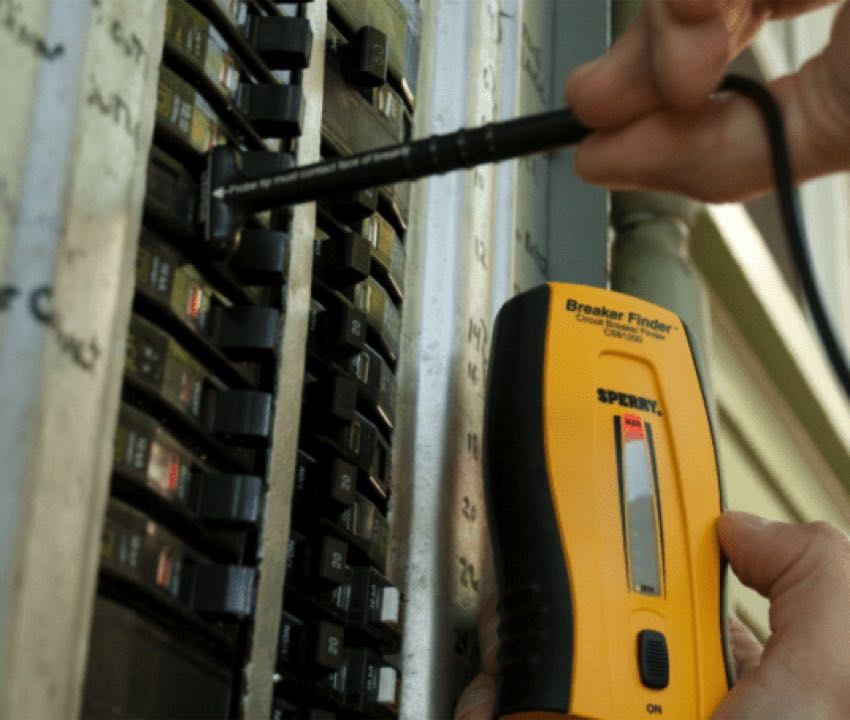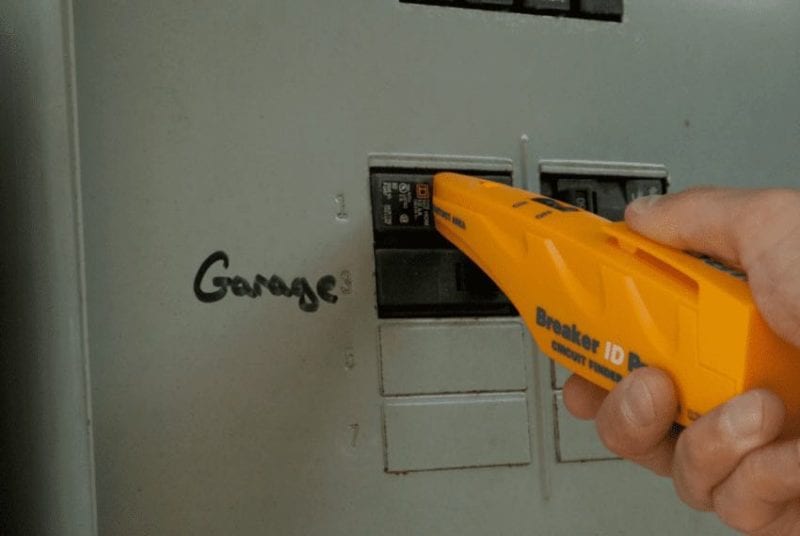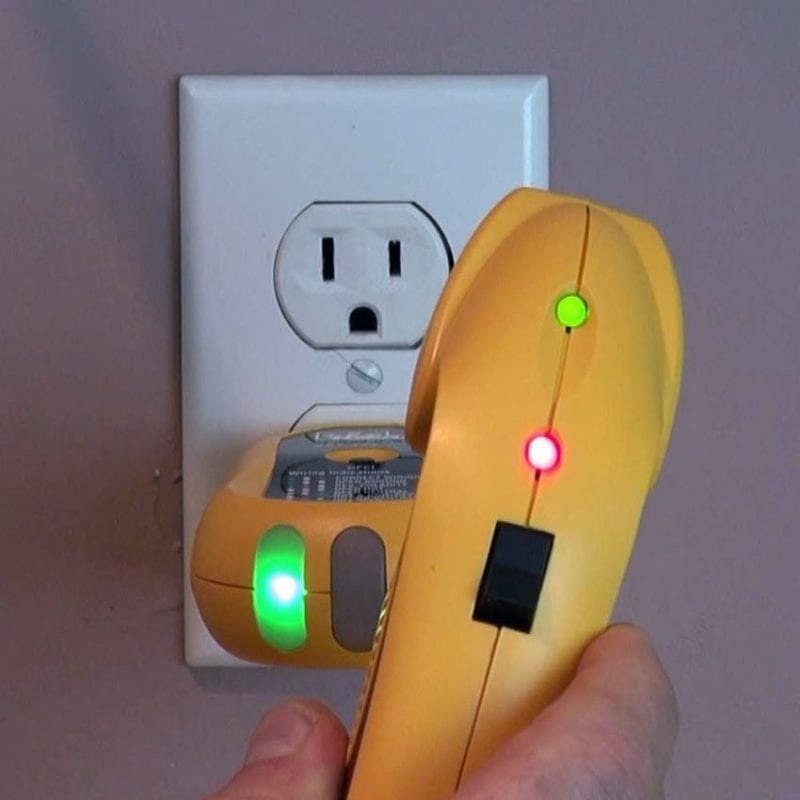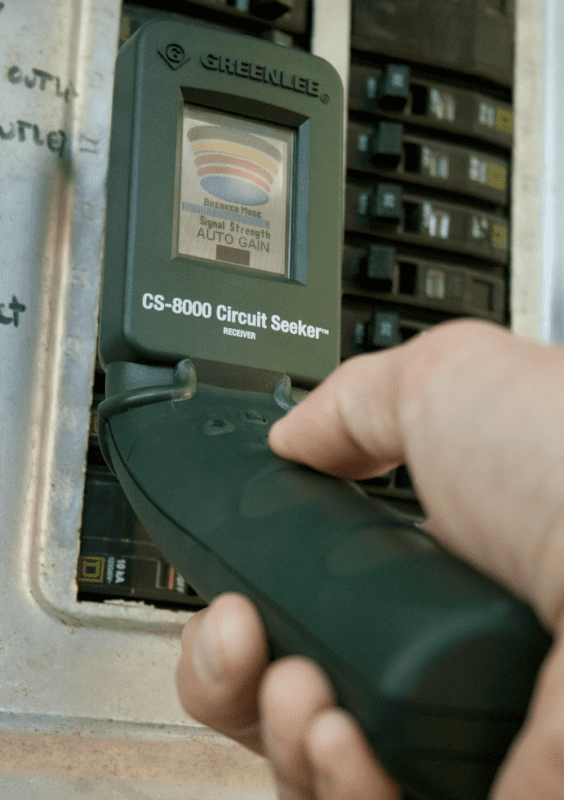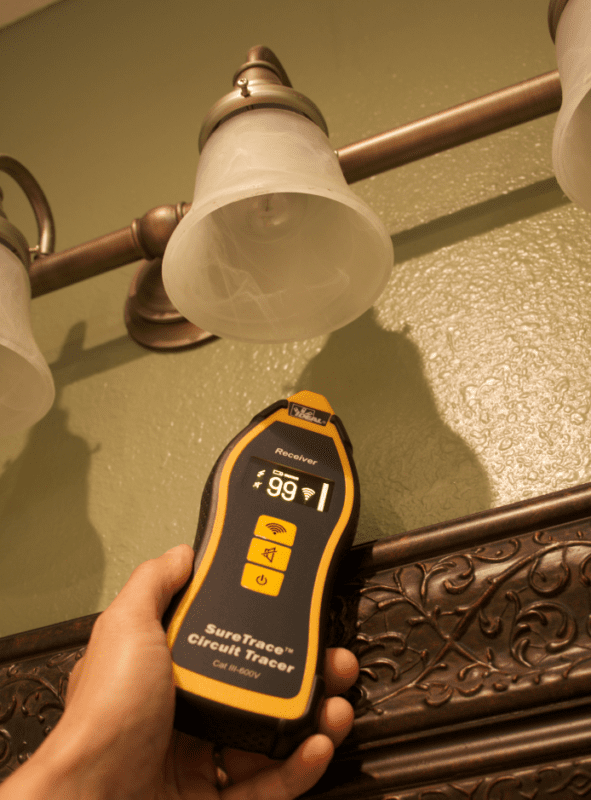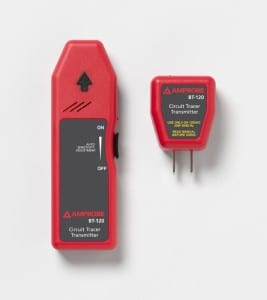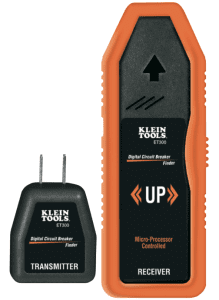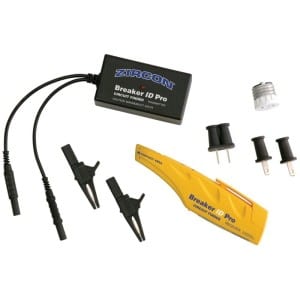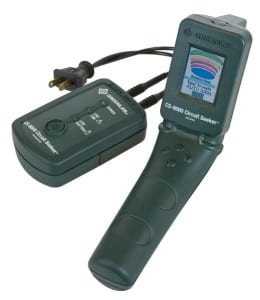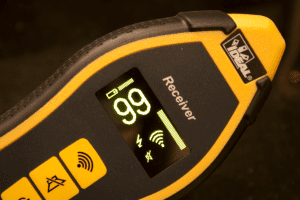As an electrician, I have some opportunities to work on some great commercial job sites. When I say “great” I mean intensely complex and challenging. In comparison to some of those larger projects, residential remodels feel like a refreshing change of pace. It also lets me dust off and use some tools that have been lying somewhat dormant in my tool bag. On a recent remodel I took the opportunity to coordinate with Pro Tool Reviews. I used my own circuit breaker finder but also integrated eight other tools as well. Having used many of these tools—but by no means all of them—I wanted to really see who made the best circuit breaker finder and tracer.
Circuit Finding vs Circuit Tracing Tools
It may help to first understand how circuit breaker finders work and how they differ from circuit tracers. Suffice it to say, these products span the whole range of circuit-related tools. This was a good opportunity to use a lot more of the available products on the market and see which circuit finders and tracers worked the best. If you’re an electrician working on residential or commercial projects, these really are must-have tools.
These tools come in handy when rewiring homes during remodeling. Frequently, you need to locate circuit breakers in a panel box. Other times, you may need to move a wall. When remodels include interior wall removal, you have to understand the wiring so you don’t create more work than necessary. All in all, I had three different jobs lined up with which to test out these tools, and I couldn’t wait to get to work.
The term “circuit breaker finder” always bugged me. Why? Because I always know where the circuit breaker is—it’s in the panel where I left it. But since all of these tools work by transmitting a signal on a particular circuit, you end up doing exactly that—locating the associated breaker for that traced circuit. When labeling a panel, you systematically go through the circuits in the home. The panel labeling process, however, jumps around from breaker to breaker as you go through the process of discovery.
Best Entry-Level Circuit Breaker Finder and Tester
Klein ET300
Three of the tools I tested, the Amprobe BT-120, the Triplett Breaker Sniff-It (9650), and the Klein ET300 are all built from the same platform. In fact, they can all work interchangeably with their single pole transmitters. (I tried them all in various configurations.) That’s not to say that you should interchange them or that they are completely identical. (It’s possible that the sensitivity settings are slightly different for each.)
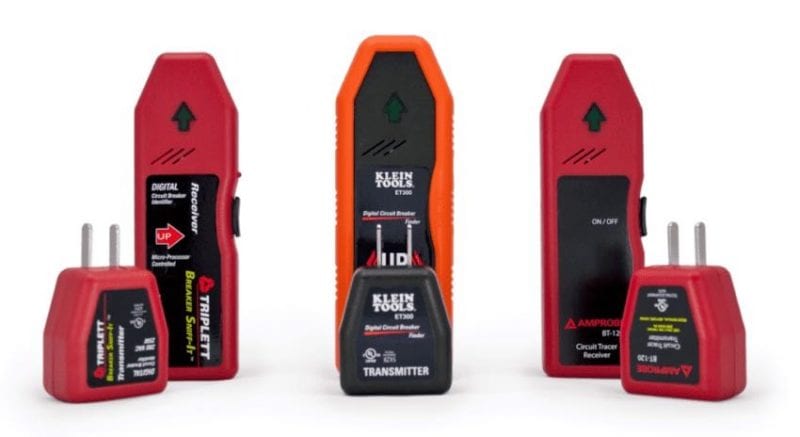
These are very basic models that form the entry-level for these tools. They work fairly well, though you have to be patient and may need to troubleshoot when you get ghosting from nearby circuits. The Klein comes with an orange rubber overmold that protects the unit and at least partially helps the side-mounted on/rest button from accidentally activating every three seconds. No such luck on the other two models—throw them in a tool bag, and you’re sure to go through batteries like I go through a bowl of popcorn.
Incidentally, the Klein also comes with a two-year warranty while the Triplett Breaker Sniff-It includes a limited lifetime warranty. All in all, these breaker finders did the job, only once getting a little sidetracked on a particularly active circuit that I know had lots of RF devices attached, including uninterruptible power supplies, battery backups, and various home theater equipment.
Best Circuit Breaker Finder for the Money
UNI-T AC Circuit Breaker Finder with Integrated GFCI Outlet Tester
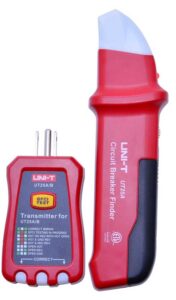
When using an indoor electrical panel I really liked using the UNI-T AC Circuit Breaker Finder with Integrated GFCI Outlet Tester. Right from the start, I appreciated that this tool had an integrated LED indicator light and sensitivity adjustment. It’s activated automatically and has an audible alert once you find the right breaker.
The transmitter is also a step up, with a socket test mode that audibly and visibly identifies missing earth and neutral as well as reversed wiring. UNI-T has a very clear guide printed in the UT25A outlet tester that lets you know exactly what’s going on. The detector runs on a single 9V battery. At $34, I find it hard not to recommend it.
Best Circuit Breaker Finder for GFCI
Sperry Instruments Breaker Finder (CS61200)
In addition to finding breakers, I was also able to test the correct wiring of GFCI circuits with the Sperry Instruments Breaker Finder (CS61200). This unit is unusual in its form factor. It separates into two sections, and the lower transmitter portion has a dual function as a socket tester with a GFCI test. The only problem with this tool is that most outlets are oriented such that the fault guide is upside down (and thus not visible). This isn’t a problem if the circuit is wired properly. If you want to identify a specific fault before memorizing the codes, you may have to pull out the tester to check the guide.
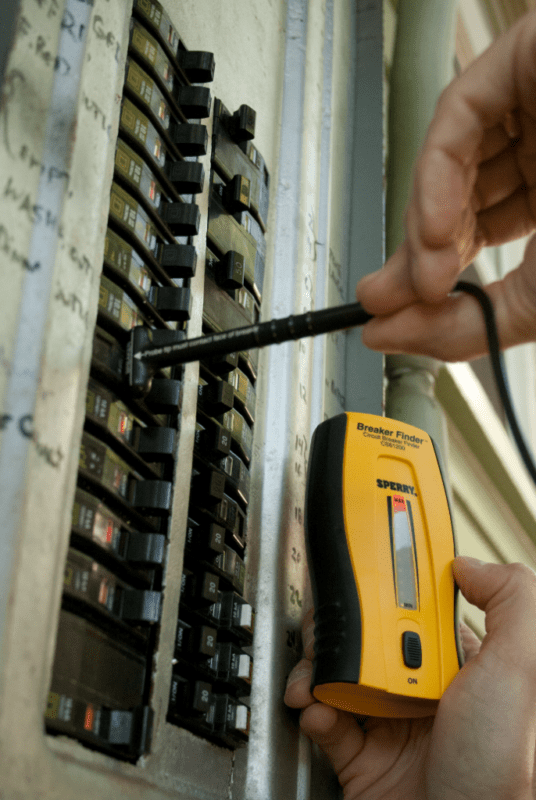
The socket also shipped with the ground plug so tight, I thought I might yank a couple of outlets from the wall before I was finished. A quick squeeze with a pair of Kleins fixed that right up. As a circuit breaker finder, the CS61200 worked well out of the box. At times I wished it came with a way to manually adjust the sensitivity.
The 10-step LEDs quickly revealed the Max range when locating the proper breaker, but adjacent breakers also yielded a similar response. That left us with the tone, which did indeed vary from the correct breaker to the next one. I found that finagling with the wand positioning and distance yielded the best method of manually adjusting the sensitivity. In the end, a good technique made this ~$52 tool one of the more reliable solutions for labeling breakers.
Best Breaker Finder for Ease of Use
Extech CB10 Circuit Breaker Finder
The Extech CB10 Circuit Breaker Finder was a surprisingly easy tool to use. Flashing LEDs and an audible beep let you know when you come to the right place. The CB10 also features a variable sensitivity adjustment to pinpoint the correct circuit breaker in a crowded panel.
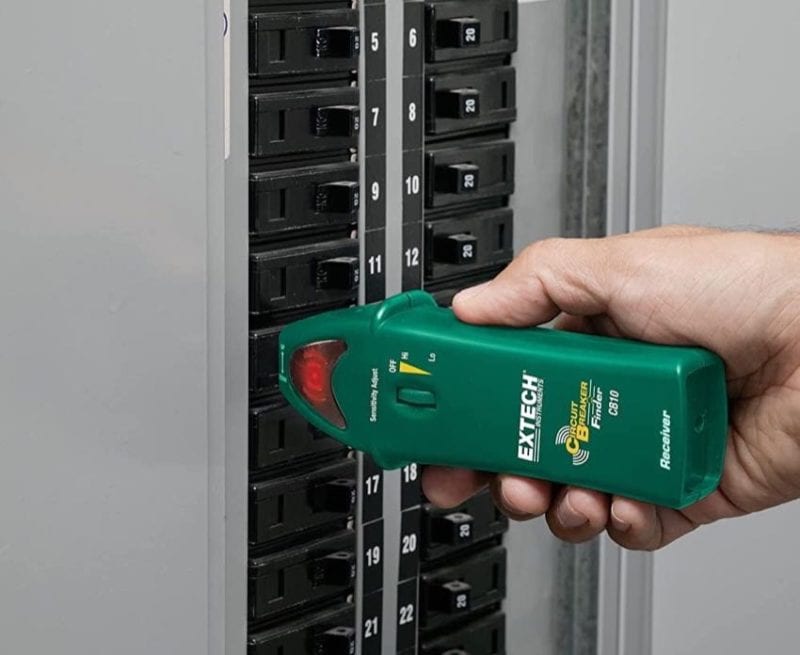
Aside from the Sperry CS61200, this is the only other tool of this type to come with a GFCI tester. For some circuits, it may be necessary to reset the receiver and scan the breakers a second time in a different location in order to differentiate false positives from the correct circuit. The variable sensitivity helps with this process. Pick it up for just $43.
Best Commercial Circuit Breaker Finder
Zircon Breaker ID Pro 300
The Zircon Breaker ID Pro 300 includes a Circuit Finder receiver and transmitter which handles up to 277V. You could theoretically use it to locate breakers for commercial lighting fixtures. The transmitter terminates to universal male connectors that allow it to mate with an included two-prong 120VAC plug, individual 120V/240V blades, and clamps.
They even include a socket adapter to let you trace out a standard 120V lighting fixture. For certain 240V applications, the single blades offer some flexibility for placement. On larger socket sizes (like older 50A range outlets), however, they may fit too loosely. For those, I still needed an assistant.
To truly locate breakers for these circuits you may need to clamp onto the wire to get a solid connection for the transmitter. Overall, the individual blades and clips are quite handy for three-phase applications. If you need the additional capability to locate breakers over 30 amps, this $200 solution just might be the best bang for your buck. This flexible kit made various circuit-tracing scenarios possible thanks to the provided accessories.
Best Circuit Breaker Finder for Tracing Live Wires
Ideal Industries 61-534 Digital Circuit Breaker Finder
The Ideal Industries 61-534 Digital Circuit Breaker Finder was the first device I used to trace a live wire. I pulled it out when attempting to discern the path taken to run an outlet for an existing wall-mounted bedroom television. Using the Ideal Industries Breaker Finder I placed the Circuit Tracer Transmitter into the outlet I believed to be on the same line. Tracing above the television’s supply outlet I was able to verify the run and tap into that outlet for additional power to the home theater.
It had limited success on thicker walls made of plaster and lathe, but in drywall, it excelled. Of course, as a circuit breaker finder, the 61-534 also works well. I particularly liked the auto sensitivity setting. It did a good job of eliminating false positives and discerning the correct circuit from adjacent breakers. For around $140, this is an amazingly flexible and versatile tool.
The inclusion of both a GFCI circuit tester and a non-contact voltage sensor (80-300VAC) does a bit more than your typical $35 breaker finder. Overall, the Ideal 61-534 circuit tracer is able to do a whole lot more.
The Best Circuit Breaker Finder for Visual Feedback
Greenlee CS-8000
I immediately liked the ergonomics of this tool. This is the first circuit seeker/tracer I’ve used that has the visual feedback facing the user straight-on. Typically the visual readouts are on the side or top. The LCD on the CS-8000 isn’t overly detailed, but that’s what makes it good. We used this tool to trace out a live wire that was in a wall being removed as part of a remodel. Obviously, this tracer is considerably more complex (and sensitive) than the products I have written about so far.
You’ve got a 5-step scale for relative signal strength in addition to an absolute signal strength meter. The display tells you when you are in Auto Gain or Manual Gain mode as well as Breaker Mode or Search Mode. It also correctly identifies a live or open circuit. And that’s it. It doesn’t gum up the screen with other details you don’t need, allowing you to use the tool efficiently and effectively.
The CS-8000 was fast. This was largely because the LCD screen and audible tone made it extremely simple to know what was going on at any given moment. It was also apparent that the Greenlee was extremely proficient at locating breakers. It gave less false positives and had the ability to scan the breakers and set its own sensitivity at a much faster pace—or so it appeared.
The CS-8000 could also quickly identify the correct panel when I was dealing with multiple panel boxes. I just put the tool in Search mode and swept the four corners of each panel to determine the one with the highest signal strength. At around $920, it costs more than other tracers, but you get a whole lot more functionality.
Most Consistently Accurate Circuit Breaker Finder
Ideal SureTrace 61-957
The Ideal SureTrace 61-957 kit was next. I performed the same tasks with it as I did with the Greenlee. It was equally quick to use, and I liked the new “rotating” OLED display. It’s easy to identify what’s going on and highly visible in all types of lighting whereas the Greenlee CS-8000 can suffer from glare if you use it with the sun at your back. The display also shows you 99 steps of signal strength, which is a lot of resolution.
The CertainCircuit feature was also really nice in that it kept me from having to go back into the building to verify that the correct circuit had been cut after I tripped the breaker. Instead, an icon on the screen told me that when I turned the circuit off, the transmitter was indeed reading it as having been deactivated.
I bounced between the Ideal 61-957 kit and the Greenlee CS-8000. These are two very different systems that go after the same tasks and, as far as I can tell, the same market. Greenlee definitely ups the ante with its ergonomics, but the Ideal was nearly foolproof in its execution. At $841 it had to be.
Conclusions
For basic circuit breaker finding, most of these tools did an excellent job. The three least expensive models are capable of locating most breakers. They did great on a home where we had to completely relabel the electrical panel following a rewire. Tossing them into a tool bag might net you some dead batteries due to the accessible power buttons. Aside from that, there’s nothing wrong with an inexpensive tool that works.
Features matter, however. If you find yourself constantly checking GFCI circuits, you don’t need to carry around a separate tool. Also, the convenience of the two-in-one Sperry is a great design that uses audible cues to a larger degree than many of the others. The LED light on the VersativTECH breaker finder is brilliant (literally) and not something to be overlooked.
If advanced features are what you need, The Ideal Industries 61-534 is the best of both worlds—or at least a little of both worlds. It’s not as sensitive as a true circuit tracer, but it seemed to do a great job of tracking with live wires just below the surface of a wall of sheetrock. Since it’s also a pretty good breaker finder, it’s a real steal of a tool.
Two Great Choices for Pro Users
For actual live and open circuit tracing, both the Greenlee CS-8000 and the Ideal SureTrace kits are fantastic. I liked the feel of the Greenlee better, but the CertainCircuit feature of the Ideal RC-959 is a stroke of genius. It simply sends a signal from the transmitter to the receiver to let it know if the line is live or not. When it is, there’s a lightning bolt icon. If dead, that icon goes away. Not having to go back and check to see if the power was cut to the transmitter when you test the breaker is a really handy function.
While Ideal covers its tool against defects for a generous 2-year period, Greenlee offers its tool with a limited lifetime warranty. That may play into your high-priced decision as well. Whatever you choose, either of these tools will make you feel a little bit like a superhero. Once you get acclimated to the setup and best practices, you will be able to see through walls like Superman and trace circuits and spot shorts more quickly than you ever thought possible.
Tool by Tool
Amprobe BT-120
Part of the “gang of three”, this circuit breaker locator was actually quite accurate in our testing and was nearly interchangeable with both the Klein and Triplett models. Given the price, it’s hard to pass this up in a pinch, though there are more feature-rich choices. One negative shared by this tool and the Triplett is that they will turn on when bumped. Toss this in a tool bag, and you may find the battery drained before you actually get to use it.
- Pros: Inexpensive enough to be in every tool bag, Reasonably accurate.
- Cons: Turns on easily and might drain the battery if stored loose in a tool bag.
- Verdict: An affordable, no-frills breaker-finder.
Triplett Breaker Sniff-It 9650
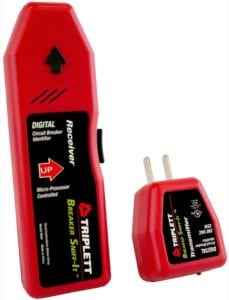
Like the Amprobe BT-120 and Klein ET300, this breaker finder worked very reliably but offered no particular frills or features worth highlighting. At a price point that is too cheap to allow anyone an excuse not to have one, this tool (or one of its compadres) should easily be a staple of tool bags everywhere. Triplett has a distinct honor, however, of being the only manufacturer to not include the required 9V battery.
- Pros: Simple design, Reasonably accurate, Super inexpensive.
- Cons: 9V not included, Turns on easily and might drain the battery if stored loose in a tool bag.
- Verdict: An affordable, no-frills breaker-finder, but don’t forget the 9V.
Klein ET300
Klein apparently couldn’t sit by and use the same form factor as Amprobe and Triplett without doing something, so it added a nice protective rubber cover for the receiver. It gives it some protection, but more importantly, it makes the switch less prone to turning the receiver on by accident when you nudge it. For the extra $5, I’d opt for this tweaked model in a heartbeat.
- Pros: Nice protective rubber slip-case, Great value, Reasonably accurate.
- Cons: Can still accidentally tun on when tossed in a tool bag.
- Verdict: An affordable, no-frills breaker-finder with a little extra protection.
Sperry Instruments Breaker Finder CS61200
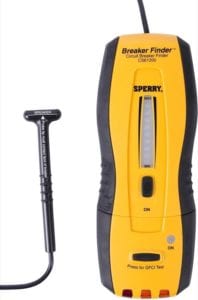
There’s a lot to like about this breaker finder. From the two-piece compact design to the magnetic base that holds the receiver in place while you guide the wand over the breakers, Sperry put some serious thought into the CS61200. The transmitter on this tool also doubles as a GFCI tester. It cost the least of the two tools tested which had that feature. A combination of visual alerts (there are ten LEDs that light up to indicate the signal strength) and audible beeps cue you as to which breaker is the right one. The wand tended to be a tad touchy, but the fact that you can vary its position and distance from the breaker also gives you some ability to customize the sensitivity and hone in on the correct of two adjacent breakers.
- Pros: Nice all-in-one design, Magnetic base on receiver, GFCI tester, Compact and portable.
- Cons: Relies a lot on audible cues when dealing with adjacent breakers.
- Verdict: An inexpensive compact and portable circuit breaker finder that has lots of flexibility and features.
Extech CB10
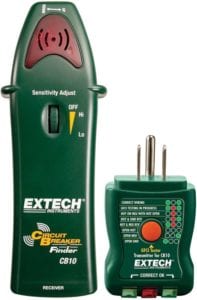
The Extech CB10 might not win a beauty contest, but this tool simply works. Unlike the retired CB20, it does require the use of a screwdriver to change the receiver’s battery. Zircon has the only other tool that doesn’t. This tool makes it very easy to identify breakers. A simple light at the translucent tip flashes when it finds the correct live circuit and the receiver beeps. This is the second tool we’ve tested whose transmitter includes a GFCI tester.
- Pros: Ergonomic grip and positioning, Easy to read—even in dimly lit rooms, GFCI tester.
- Cons: A bit more expensive than other similarly-featured tools, Would benefit from a sensitivity dial.
- Verdict: If you’re doing a lot of circuit breaker finding, this tool helps you move quickly.
Zircon Breaker ID Pro 300
The Zircon Breaker ID Pro 300 lets you hold the tool at a slant, so you’re not completely perpendicular to the electrical panel. It also allows tool-less 9V battery changes in the receiver. Feature-wise, it’s pretty simple except that the case (a very nice foam-lined mini road model) includes all sorts of connectors and adapters for use with finding circuit breakers via 220V/230V lines and 120V lighting fixtures. In addition to the 120V socket adapter, the universal transmitter’s 12″ long male leads fit into a single pole AC plug, a pair of clamps, or a pair of individual blades. The Zircon isn’t a fancy unit as far as the receiver goes, but it was consistently accurate in my tests.
- Pros: Consistently accurate results, fully-featured kit, nice case.
- Cons: A pricier breaker finder.
- Verdict: A higher-priced, but more robust kit for finding circuit breakers
Greenlee Circuit Seeker CS-8000
The fully-featured CS-8000 kit is a real workhorse and unique among circuit seekers. It’s by far the most ergonomic tool I’ve yet used for this kind of work, and it is quick and easy to use—there’s not a sharp learning curve. The kit includes two 12′ test lead extensions so I could tie into a branch circuit when needed. There’s also a ~3′ AC plug adapter, two clamps, and a single AC blade connector. In Search Mode, this tool is amazingly fast at finding and following live circuits or locating breakers in a panel. The flexible kit makes the tool especially adept at configuring it to trace conduits and shorts as well.
- Pros: Easy-to-read LCD screen, Incredibly ergonomic, Long test leads, Very accurate.
- Cons: Not inexpensive, Difficult to adjust sensitivity quickly, Can be misled by nearby fluorescent lighting.
- Verdict: This tool steps you up to the big leagues and lets you reliably and quickly trace live or open circuits
Ideal SureTrace Open/Closed Circuit Tracer 61-957
Ideal has three available SureTrace kits, and this is the middle child. The 61-957 includes a high-end receiver with a gyroscopically-controlled OLED screen that rotates its display so that it’s always right side up. Also included are accessories that let you do everything needed to trace a live or open circuit behind walls or within a conduit. Possibly most impressive about this system is the CertainCircuit detection, a simple but effective system that confirms when the tested circuit has been de-energized at the breaker. It eliminates having to go back inside and visually verify that the correct breaker was deactivated.
- Pros: Auto-rotate OLED display, Very accurate, CertainCircuit detection, Simple sensitivity adjustments.
- Cons: You pay for what you get and can be misled by nearby fluorescent lighting.
- Verdict: Ideal has stepped up its game once again with practical features and a nearly foolproof system

